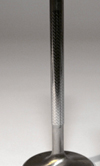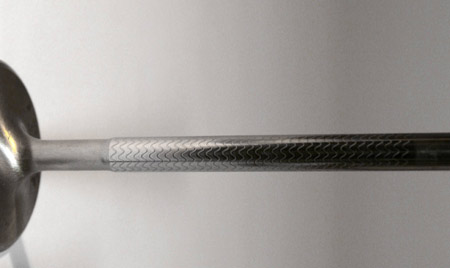Valve-stem texturing - snake oil or snake skin?
 The matter of ensuring that valve-stem lubrication is sufficient has two main benefits. First, any friction between stem and guide creates energy that is necessarily subtracted from crankshaft output power and converted to heat. Minimising this is clearly a desirable aim. Second, if the lubrication is sufficient, we minimise the rate of wear of the valve guide and valve.
The matter of ensuring that valve-stem lubrication is sufficient has two main benefits. First, any friction between stem and guide creates energy that is necessarily subtracted from crankshaft output power and converted to heat. Minimising this is clearly a desirable aim. Second, if the lubrication is sufficient, we minimise the rate of wear of the valve guide and valve.
There are a number of surface treatments that aim to reduce friction and make the stem less susceptible to wear, and these have typically included heat-treatment processes such as nitrocarburising of steel valves and processes such as coating the stem with titanium nitride, chromium nitride or the ubiquitous DLC. All of these increase the hardness of the stem surface and lower friction compared to an uncoated valve.
However, none of these treatments fundamentally change anything about the lubrication conditions or help to produce or sustain an oil film. Study of a textbook on fluid film lubrication will reveal that flat surfaces in linear sliding will not generate pressure in an oil film (thrust bearings are an example of this). To generate an oil film, there is some change in the surface required, such as dimples, steps, grooves and so on, or some movement of the surfaces towards each other (squeeze film lubrication).
An alternative to coating valve stems would be to texture them so as to provide conditions more conducive to forming an oil film. Race valves are available which have textured stems, and the benefits in terms of lubrication are twofold. The unusual texture of the stem, in conjunction with relative movement, naturally creates conditions that produce pressure in a fluid film, but the texture can also help to retain oil within the small clearance between the stem and guide. The texture is made up of 'waves' in a regular and repeated pattern along the guided portion of the valve stem.
The problem with lubrication of a contact such as a valve and guide is that the motion is reciprocating rather than continuous, and this is not helpful in sustaining a lubricating film. Hydrodynamic lubrication, as the name suggests, relies on there being some relative movement between components. Even with texture, or other features, lack of relative movement means that a hydrodynamically generated oil film cannot be sustained.

You may be asking why there is any requirement for lubricating oil to be present when the valve is not moving. The answer is that the presence of oil is of benefit during the period when the hydrodynamic oil film is being re-established. Until fully established, the contact is one of mixed or boundary lubrication, with a mixture of dry and lubricated contact. The 'mixed' coefficient of friction depends on the coefficients of friction for both lubricated and dry conditions, and falls as fully hydrodynamic conditions are established.
To minimise friction during the mixed lubrication part of the valve motion, it is an advantage to decrease the dry friction coefficient of the stem/guide contact. The textured stems are supplied with a polymer-coated stem, which is often used in conjunction with an underlying hard PVD coating.
Fig. 1 - 'Snake skin' textured valve stems are reputed to offer significant improvements in terms of friction and wear of the stem/guide contact (Courtesy of Sinus Valves)
Written by Wayne Ward